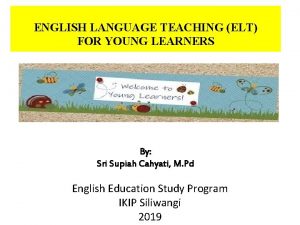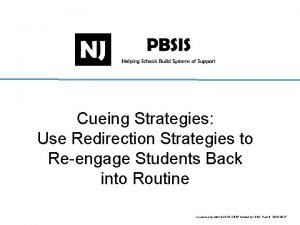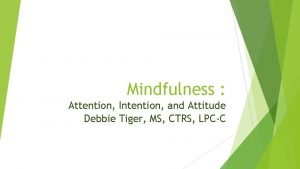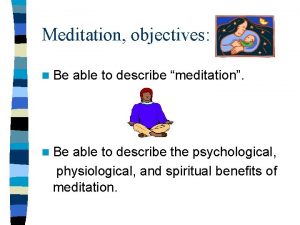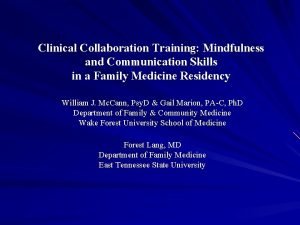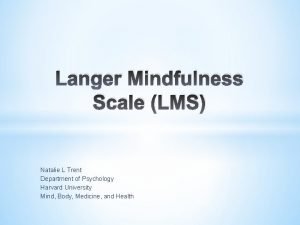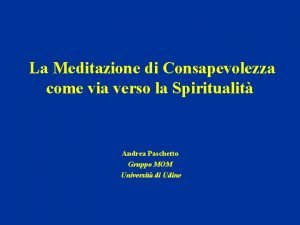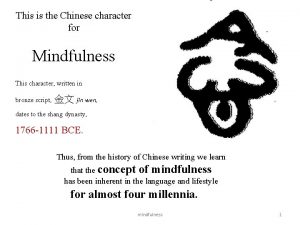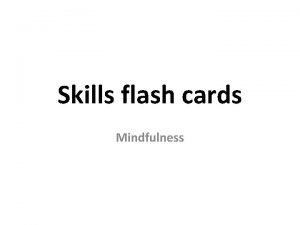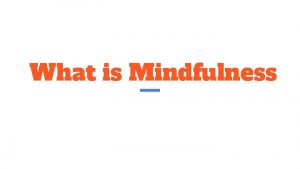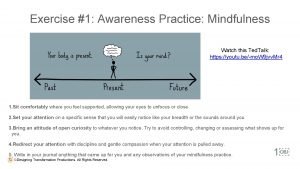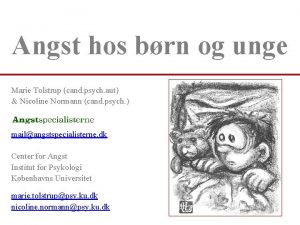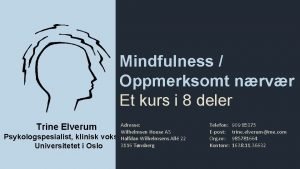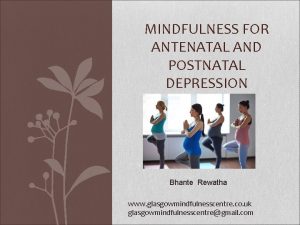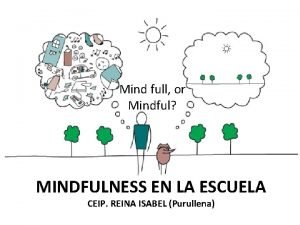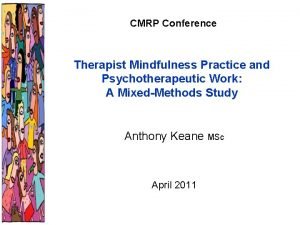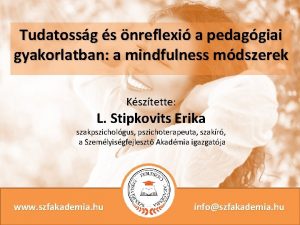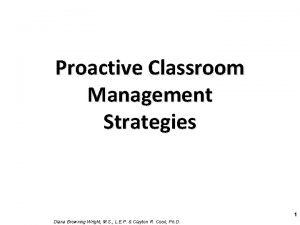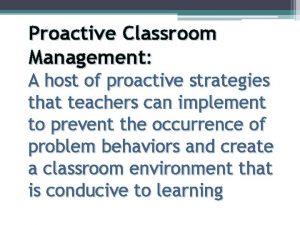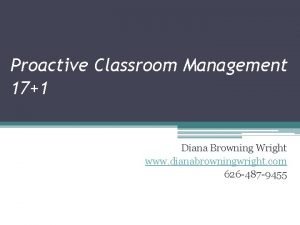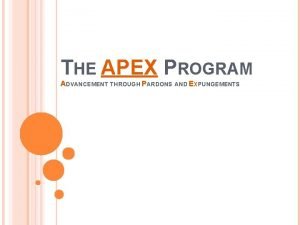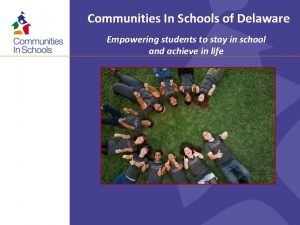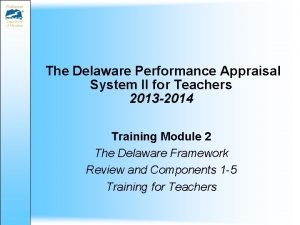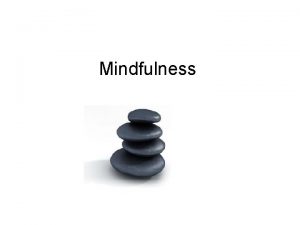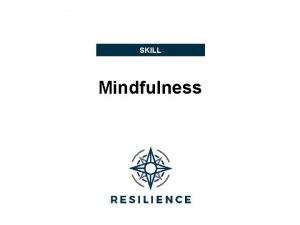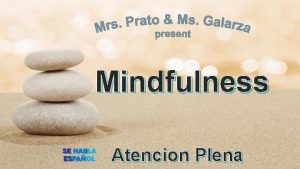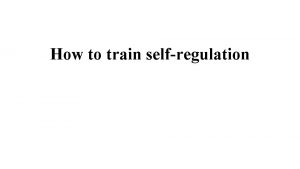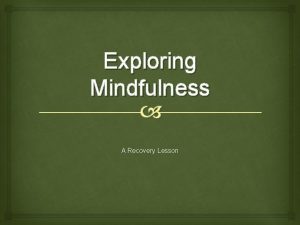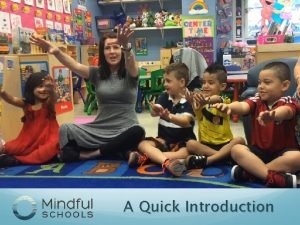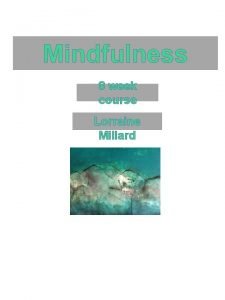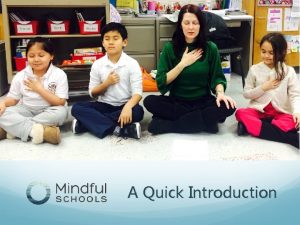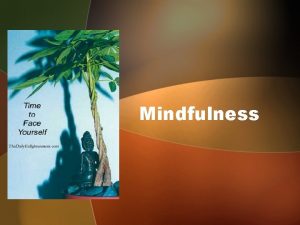Mindfulness for SelfRegulation Classroom Strategies for Teachers Delaware









































- Slides: 41

Mindfulness for Self-Regulation: Classroom Strategies for Teachers Delaware Positive Behavior Support Project Niki Roberts Ed. S. NEPBIS Leadership Forum, May 2018

DE-PBS Project is on going collaboration between the Delaware Department of Education and the UD Center for Disabilities Studies

Take a moment to complete the MAAS survey Brown & Ryan, 2003

Purpose • To link principles of mindfulness and self-regulation • To gain exposure to classroom strategies which foster mindfulness • To map mindfulness strategies onto a classroom PBS matrix

Can you think of a student like this? Jimmy loves playing soccer at recess. One day, he races out onto the playground with his friends and notices the soccer goals have been moved. No soccer today. Jimmy runs to the teacher and begs her to call for the soccer goals. The teacher reminds him that there are other choices but he continues to escalate and begins to cry. He takes most of the recess period to calm down before choosing an alternate activity. What skills does Jimmy need to enjoy recess, even when his favorite activity is unavailable?

SEL Skills to Self Regulate • • • Self awareness (identify emotions) Self management (impulse control) Social awareness (perspective taking) Relationship skills (communication) Decision making (solve problems)

A child with good self regulation skills can • • Stop playing that video game and come to dinner Pick up their toys when asked Turn their attention to an adult when asked Withhold the impulse to – Grab another’s toy – Hit another child – Scream when they don’t get their way • Maintain attention to a particular task even in the context of distractions Biglan, 2018

Mindfulness Defined "Mindfulness means paying attention in a particular way: on purpose, in the present moment, and nonjudgmentally (Jon Kabat-Zinn). ” “The process of noticing new things and drawing novel distinctions which keeps us situated in the present (Ellen Langer). ”

The ability to purposefully attend to thoughts, feelings and sensations while ignoring others. Attention Helps a student to: • NOTICE their thoughts, feelings and sensations • Prevent escalation of difficult emotions Felver et al. , 2013

An orientation to the current experience that is characterized by curiosity, openness and acceptance. Helps a student to: • Think about their experiences in new ways, • Slow down to control impulses • Notice things for what they are (neither + or -) • Understand that events are not inherently good or bad: it is thinking them that makes them so. Felver et al. , 2013

What is Mindfulness? Stimulus Attention Flexible Thinking Mindfulness Response

What is Mindlessness? Stimulus Automaticity Categorical Thinking Mindlessness Response

Let’s put it all together… Attention Mindfulness Self Regulation Flexible Thinking

Survey Says…

1. Seek out, create, and notice new things. 2. Realize how behavior can be understood differently in different contexts. 3. Reframe mistakes into successes. 4. Be aware that stress (and all emotions) are the result of our views about events. 5. Be authentic. (Caprino, 2014)

Self Regulation skills at Work… https: //www. youtube. com/watch? v=QX_oy 9614 HQ What self regulation strategies did the children use to avoid eating the marshmallow? How might mindfulness enhance the self regulation skills of the children who did not wait to eat the marshmallow?

Mindfulness Tools for Students

Research about MBI with youth • Small to moderate effect sizes • Typical outcomes measures include: cognitive performance, emotional problems, stress/coping, resilience and third party ratings (e. g. parent and teacher questionnaires related to aggression, social skills, wellbeing, or attention) • Results were strongest in relation to cognitive performance and resilience to stress • Results suggest MBI have the greatest impact with at risk youth Zenner, Hermleben-Kurz & Walach, 2014 Zoogman et. al. , 2014

Common Elements of MBIs • • • Breath awareness, working with thoughts and emotions, psycho-education, awareness of the senses and practices of daily life, group discussion, body-scan, kindness practices, home practice, body-practices (like yoga) Zenner, Hermleben-Kurz & Walach, 2014).

Breathing and Mindfulness • Breathing is always with us, so paying attention to it requires nothing extra • We breathe 20, 000 times a day (15 per minute) • When we feel panicky, there is a decrease of carbon dioxide in the blood • Diaphragmatic breathing is a method of balancing the oxygen and carbon dioxide levels in the blood. It only takes 4 minutes to reregulate the system via diaphragmatic breathing Holland & Sisson, 2014

4 x 4 Breathing • Focus on breathing for 4 minutes, counting to 4 (one count per second) on inhales and 4 on exhales • The breathing is diaphragmatic • Later increase to 8 seconds on the exhale • 4 x 4 breathing cuts your rate of breath in half, and at 4 x 8 then breathing is only 5 breathes per minute. • Focusing on the long exhale slows the heart rate down/stops the fight or flight response Holland & Sisson, 2014

Belly Breathing, Alternate Nostril Breathing, Count to Ten, good in/bad out, bumble bee breath Long slow breaths activate the parasynthetic nervous system which controls the relaxation response Breath Awareness 2 to 1 Breath, Lion Breath, Bunny Breath, Conductor Breath Quick breaths activate the synthetic nervous system which controls the arousal response

Working with Thoughts/Emotions • Movie directors: constantly playing scripts and clips in our minds. Often leads to an emotional experience. • We often react and respond to the script in our minds, not what is actually occurring in the present. • Automatic pilot • 80 -90% of our thinking is repetitive • Our thinking minds should be tools; pick it up when we need it, then set them down (at times we make connections and predictions)

The Guest House This being human is a guest house. Every morning a new arrival. Ajoy, a depression, a meanness, some momentary awareness comes as an unexpected visitor Welcome and entertain them all! Even if they’re a crowd of sorrows, who violently sweep our house Empty of it’s furniture, Still, treat each guest honorably. He may be clearing you out For some new delight. The dark thought, the shame, the malice, Meet them at the door laughing, And invite them in. Be grateful for whoever comes, because each has been sent as a guide from beyond. -Rumi Discussion Questions: What do you think the poem means? “Bad” moments help you know that other moments are “good. ” What does this mean to you? What feelings are in your guest house right now? When you experience negative feelings, can you just take them in as information for yourself? How might you do that? How do you currently deal with negative emotions? What does Rumi mean that negative emotions can “clear you out for some new delight? ” Biegel, 2009, pg. 73 -75

Social Stories

Automatic Thoughts Helpful Self Talk Unhelpful Self Talk Rate Yourself on a Scale on how much you believe thoughts about yourself 1 (not at all) to 5 (completely) I can do this This is too hard I’m awesome at this I’m not good at this I can keep trying I give up I can always keep I can’t make this any trying OR I can ask better for help Plan A didn’t work Good thing there are 25 more letters of the alphabet 1. 2. 3. 4. Nothing works out for me People don’t understand me I make too many mistakes I am not good enough When we feel good, we have a harder time believing these things about ourselves and the thoughts don’t come up. But when we are stressed, these thoughts pop up more frequently. Our mood affects our thinking and our thinking affects our mood. (Vo, 2015)

Working with Thoughts and Emotions https: //www. transforminged ucation. org/rubber-bracelets -birthdays-and-wonder/

Size of the Problem Remember: stress (and all emotions) are the result of our thoughts about events.

Awareness of the Senses Outside/in Meditation Intuition Game Chime Listening Mindful Eating

Body Practices • • Musical poses, Pose of the day, What am I? Strike a pose Co n po side r s po e car addi n cla ste ds ssr r to or g a oo m’ your are s br ea a k

The Body Scan Meditation

Kindness Practices • Define Kindness as a universal classroom expectation • Link kindness to brain research: mirror neurons • Use a job list that includes rotating roles for everyone in the class (or a list of acts of kindness that students can sign up for periodically) • Practice giving and receiving complements • Gratitude exercises

Kindness Practices Loving Kindness Meditation

Group Sharing Mindfulness Discussion Expectations: 1. Listen all the way to the end of the question before answering. 2. Listen with your whole body without reacting until others finish speaking. 3. Pay such close attention to what someone else is saying that you could repeat or explain in to someone else. 4. Listen for ideas that are different than your own and ask questions if you don’t understand. 5. When you notice you are tuned out, try a mindfulness trick to re-join the conversation.

Group Games

Mindfulness and PBi. S 1: 1 FBA/BIP Group mindfulness with students of similar needs DBR; prompting/reinforcing use of Strategies Integrated with School Wide PBIS Program Daily mindfulness practices Mindfulness research has shown greater improvements in outcome measures at follow up. Daily mindfulness activities helps bring students back to the previous practices. Holland & Larkin, 2014

Expectation Mindfulness Skill I use 4 x 4 breathing when I sense strong emotions Be Safe I label the size of the problem before I act I listen to others before I react or respond I find multiple ways to solve a problem Be Respectful I look for ways to demonstrate kindness I care about how others feel and think I observe my thoughts and emotions when I am learning Be Responsible I learn from my mistakes I use my tools to stay tuned-in during class

School-wide Expectations Classroom Routines/Procedures, Socio Emotional Skills Classroom Rules Entering Classroom Resolving Conflict Cooperative Learning Groups Making Friends SEL Skill Attention Signal : 4 fingers = 4 x 4 breathing • Use kind words & actions Be Respectful Be Responsible Be Safe • Use appropriate voice level • Enter/exit classroom prepared • Think of multiple ways to solve the problem • Use inside voice • Follow adult directions • Place materials in correct area • Take care of materials/equipment • Begin warm-up promptly • Keep hands, feet & objects to self • Walk • Use all equipment & fic ci materials e p appropriately S a h e B v s ior • • Give an “I” Statement Think about how others feel Use 4 x 4 breathing in a safe space Label the size of the problem before acting • • Listen to others Accept differences Encourage others Wait your turn to speak • Use Time Wisely • Contribute • Complete your part • Use Materials Carefully • Stay in your designated area

Matrix can be a working document… You can add skills to it as they are taught.

Questions? Niki Roberts robertsn@udel. edu 302 -831 -6735 www. delawarepbs. org

Resources Biglan, T. (2018). The pax good behavior game: a powerful supplement to PBIS. [Power. Point slides]. Retrieved from: https: //new. apbs. org/sites/default/files/conference-2016/presentations/swk 105 -biglan-apbs 2018. pdf Brown, K. W. & Ryan, R. M. (2003). The benefits of being present: Mindfulness and its role in psychological well-being. Journal of Personality and Social Psychology, 84, 822 -848. Butler, J. (2016). Mindful classrooms: The educator guide. Publisher: Author. Caprino, K. (2014, Feb 12). 5 mindfulness steps that guarantee increased success and vitality. Retrieved from https: //www. forbes. com/sites/kathycaprino/2014/02/12/5 -mindfulness-steps-that-guarantee-increased-success-and-vitality/#19 bc 51066710 Felver, J. , Doerner, E. , Jones, J. , Kaye, N. , & Merrell, K. (2013). Mindfulness in school psychology: applications for intervention and professional practice. Psychology in the Schools, 50(6), 531 -547. Flynn, L. (2013). Yoga for children: 200+ yoga poses, breathing exercises, and meditations for healthier, happier, more resilient children. Avon, MA: Adams Media. Guber, T. L. , Kalish, L. (2005). Yoga pretzels: 50 fun yoga activities for kids and grownups. Cambridge, MA: Barefoot Books. Holland & Sisson (n. d. ). Advanced mindfulness and acceptance practice in the schools. [Power. Point slides]. Retrieved from https: //nasp. inreachce. com/ Holland & Larkin (2014). A three tiered prevention-intervention school based mindfulness program. [Poster]. Retrieved from: http: //mps. milwaukee. k 12. wi. us/MPSEnglish/CAO/Documents/PBIS/Mindfulness 3 Tiers. Handout. pdf Igniter. Media. (2009, Sep 24). The Marshmallow Test [Video file]. Retrieved from https: //youtu. be/QX_oy 9614 HQ Kuypers, L. M. (2011). The zones of regulation: A curriculum designed to foster self-regulation and emotional control. Santa Clara, CA: Think Social Publishing, Inc. Langer, E. J. (1997). The power of mindful learning. Cambridge, MA: Da Capo Press. Rechtschaffen, D. (2014). The way of mindful education: Cultivating well-being in teachers and students. New York, NY: W. W. Norton & Company, Inc. Snel, E. (2013). Sitting still like a frog: Mindfulness exercises for kids (and their parents). Boulder, CO: Shambhala Publications. Vo, D. X. (2015). The mindful teen: powerful skills to help you handle stress one moment at a time. Oakland, CA: Instant Help Books. Zenner, C. , Herrnleben-Kurz, S. , & Walach, H. (2014). Mindfulness-based interventions in schools-a systematic review and meta-analysis. Frontiers in Psychology, 5, 603.
 Kim kroll
Kim kroll Classroom language for teachers
Classroom language for teachers Redirection strategies for teachers
Redirection strategies for teachers Attention intention attitude
Attention intention attitude Describe meditation
Describe meditation Mindfulness for collaboration
Mindfulness for collaboration Langer mindfulness scale
Langer mindfulness scale Meditazione mindfulness
Meditazione mindfulness Felix compen
Felix compen Chinese symbol for mindfulness
Chinese symbol for mindfulness Mindfulness examples
Mindfulness examples Mindfulness circle
Mindfulness circle Mindfullness ted talk
Mindfullness ted talk Marie tolstrup
Marie tolstrup Ruminering definisjon
Ruminering definisjon Brainpop precision and accuracy quiz answers
Brainpop precision and accuracy quiz answers Mbct
Mbct Mind full
Mind full Mindfulness
Mindfulness Mindfulness gyerekeknek
Mindfulness gyerekeknek Sourima mal
Sourima mal Diana browning wright
Diana browning wright Proactive classroom management
Proactive classroom management Diana browning
Diana browning Classroom strategies for interactive learning
Classroom strategies for interactive learning Delaware health insurance exchange
Delaware health insurance exchange Delaware county department of human services
Delaware county department of human services Bell delaware method
Bell delaware method Delaware telebenefits
Delaware telebenefits Apex expungement delaware
Apex expungement delaware Delaware valley honda dealers
Delaware valley honda dealers Delaware health resources board
Delaware health resources board Delaware
Delaware Delaware trust conference
Delaware trust conference Seed delaware
Seed delaware Vision quest agency
Vision quest agency Cis delaware
Cis delaware Dti delaware
Dti delaware Delaware division of motor vehicles
Delaware division of motor vehicles Performance management delaware
Performance management delaware Delaware mountain group
Delaware mountain group Bell delaware method
Bell delaware method

